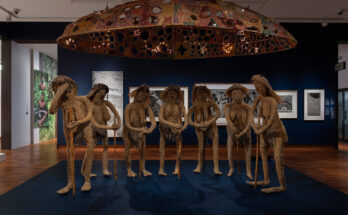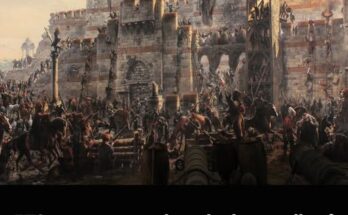Among the many treasures housed in the National Library of Poland, the Sankt Florian Psalter—an illuminated manuscript dating from the late 14th to early 15th centuries—stands out as a cultural and linguistic jewel. Written in Latin, Polish, and German, this trilingual manuscript is a testament to the rich multilingual and multicultural context of medieval Central Europe. It contains sacred texts, most notably the Psalms, but also remarkable illuminations—some beautiful, some bizarre, and a few, unsettling.
Of particular interest is a miniature figure that resembles the modern depiction of Nosferatu, or more broadly, the folkloric vampire. With gaunt features, elongated fingers, a haunting stare, and bat-like posture, this figure diverges starkly from typical biblical iconography. It raises questions: Was this a monster of superstition inserted into a sacred book? A metaphor for evil? Or a product of deeper psychological and cultural fears manifesting through medieval artistry?
This essay explores the Nosferatu-like miniature in the Sankt Florian Psalter, situating it within the manuscript’s broader context, examining its iconography, and uncovering its implications about medieval anxieties, theology, and the blurred boundaries between sacred art and folkloric dread.

1. A Trilingual Masterpiece
The Sankt Florian Psalter, or Psałterz floriański, is one of the oldest preserved examples of Polish-language biblical literature. It was likely produced in a Central European scriptorium—possibly in Silesia or Lesser Poland—between 1370 and 1405. Its trilingual composition reflects the region’s political and cultural landscape: Latin for clerical use, German for the ruling and merchant classes, and Polish for the vernacular-speaking populace.
Written on parchment and richly illuminated, the Psalter contains the Book of Psalms, a series of Canticles, and additional liturgical texts. The manuscript’s ornate initials, marginalia, and miniatures place it firmly within the Gothic tradition of book art.
2. Preservation and Legacy
The Psalter owes its name to the monastery of Sankt Florian in Austria, where it was rediscovered in the 19th century after being forgotten for centuries. Today, it is housed in the Biblioteka Narodowa (National Library of Poland) in Warsaw and is considered a national treasure of Polish medieval literature and religious heritage.
II. The Vampire in the Margins: Description of the Creature
Amid the sacred text and ornate flourishes lies an eerie figure that diverges from ecclesiastical decorum. In one of the manuscript’s marginal illustrations—possibly appearing alongside Psalm 53 or 58 (though folio placement varies by catalog)—a Nosferatu-like creature creeps along the edge of the page. Its characteristics are as follows:
- Elongated, skeletal limbs
- Bald or thinly-haired head, with pointed ears
- Pale, almost translucent skin
- Exaggerated fangs or long teeth
- Stooped or crouched posture, reminiscent of Max Schreck’s portrayal in Nosferatu (1922)
- Clawed hands reaching toward a human figure or the text itself
The creature appears almost parasitic, as if feeding off the text or looming over a figure praying beneath. Unlike the cheerful or grotesque drolleries often found in the margins of medieval manuscripts, this figure has a distinct air of menace and emotional realism rarely granted to fantastical beasts.
III. Artistic Origins and Symbolism
1. Gothic Art and Grotesque Marginalia
The inclusion of such a creature fits within a larger tradition of Gothic marginalia, where illuminators delighted in populating sacred manuscripts with wild beasts, demons, hybrid monsters, and even humorous grotesques. These images often served moralistic, symbolic, or purely decorative functions. However, the vampire-like figure of the Sankt Florian Psalter stands apart in tone—too somber for parody, too specific for abstraction.
The Gothic period saw an explosion of artistic experimentation, especially in Northern Europe. Scribes and illustrators were given a degree of creative freedom, particularly in the margins, which became laboratories of the imagination. They juxtaposed the divine and the demonic, the comic and the horrific, creating manuscripts that reflected the psychological complexity of the age.
2. The Nosferatu Motif: A Retroactive Label?
It is important to note that the term “Nosferatu” is anachronistic when applied to a 14th-century artwork. It derives from Eastern European vampire lore, and was popularized in Western consciousness via Bram Stoker’s Dracula (1897) and F.W. Murnau’s film Nosferatu (1922). Nonetheless, folkloric vampires—creatures who prey upon the living and return from the dead—were known throughout medieval Europe under different names: upiór, strzyga, nachzehrer, and vrykolakas, among others.
This creature fits within those folkloric traditions and may be a medieval representation of a revenant, a walking corpse or demon associated with disease, spiritual corruption, or unconfessed sin. Its proximity to psalmic text may signal a visual warning—a monstrous embodiment of the soul’s peril without divine protection.
IV. Vampirism and Death in Medieval Europe
1. Fear of the Undead
Medieval Europe was rife with superstitions about the dead. The fear that the deceased might return as malevolent spirits or physical beings was especially acute during times of plague, war, and social upheaval. The Black Death, which ravaged Europe in the mid-14th century, left a psychological scar across the continent.
These fears manifested in burial rituals, church doctrine, and yes, art. Corpses were sometimes buried with stones in their mouths, stakes through the heart, or bound limbs—all protective measures against revenants.
In this climate, it is plausible that the Sankt Florian illuminator, perhaps influenced by local folklore or a specific tale of vampirism, inserted a figure that symbolized the spiritual corruption that results from turning away from God.
2. Liturgical and Moral Function
The presence of a Nosferatu-like figure in a psalter may appear contradictory. But in fact, it aligns with a didactic medieval worldview. The Psalms frequently invoke divine protection against enemies, evil forces, and the “shadow of death.” A visual embodiment of that evil in marginalia reinforces the text’s urgency and relevance.
This creature may also function as a memento mori—a reminder of death’s inevitability and the grotesque nature of decay. It urges readers and worshippers to purify their souls, lest they become monstrous in the afterlife.
V. Cultural Intersections and Central European Folklore
The Sankt Florian Psalter’s trilingual nature places it at the intersection of Latin Christendom, Germanic folklore, and Slavic pagan survivals. Central Europe was a melting pot of traditions—Christianity mingled with residual paganism, and official theology coexisted uneasily with folk belief.
In Slavic and Polish folklore, figures like the upiór (a blood-sucking revenant) and the strzyga (a vampire-like witch) appear in many tales. These beings often attacked their own kin, emerged from improper burials, or symbolized unresolved ancestral sins. The resemblance between these myths and the Psalter’s creature is too striking to be accidental.
The Psalter thus becomes not only a spiritual object but a cultural artifact—one that reflects the hybridized fears of its community.
VI. Interpretations and Theories
1. Theological Allegory
Some scholars suggest that the creature might symbolize sin, temptation, or heretical thought—a spiritual parasite preying on the devout. Its location beside certain psalms, particularly penitential or imprecatory ones, may support this reading.
For example, Psalm 53, which begins “The fool says in his heart, ‘There is no God,’” is a denunciation of atheism and moral decay. Placing a monstrous figure beside such text would visually reinforce its warning.
2. Psychological Projection
Art historian Michael Camille, in his study of marginalia, noted that such figures often represent the fears, fantasies, and inner contradictions of monastic life. A cloistered monk, exposed daily to death, temptation, and spiritual struggle, might channel these tensions into grotesque images.
From this perspective, the Nosferatu-like figure is a mirror—reflecting back the inner anxieties of the religious mind: death, desire, corruption, the fear of one’s own shadow self.
3. The Artist’s Signature?
A more whimsical theory posits that the image might reflect the personal imagination of a particularly eccentric illuminator. Medieval artists, though anonymous, were not automatons—they had humor, dreams, fears. This creature might be the medieval equivalent of a horror sketch in the margins of a theology notebook.
VII. Influence and Legacy
While it’s unlikely that the Sankt Florian Psalter directly influenced later vampire fiction, its inclusion of such a figure speaks to a cultural continuity of vampiric imagery. The long fingers, crouched stance, and ghastly visage appear centuries later in early horror cinema, especially in Murnau’s Nosferatu. This may suggest deep-seated archetypes rooted in the human imagination.
Today, scholars and artists revisit this image not only for academic insight but for creative inspiration. The eerie figure from this medieval manuscript has found a place in popular blogs, art exhibitions, and discussions of gothic visual history.
VIII. Conclusion
The Nosferatu-like creature in the Sankt Florian Psalter is a haunting anomaly, a shadow among sacred words. Whether intended as a metaphor, moral warning, or cultural reference, its presence deepens our understanding of medieval spirituality and psychology. It blurs the line between religious reverence and folkloric fear, between art and nightmare.
In its skeletal fingers and hollow eyes, we glimpse not just a medieval monster—but the enduring human need to embody our fears, to confront the unknown, and to remind ourselves—through art—that evil must be named to be resisted.
Like the Psalms themselves, the image is a prayer. A prayer for protection. A prayer against darkness. A prayer that whatever lurks in the margins stays there.


